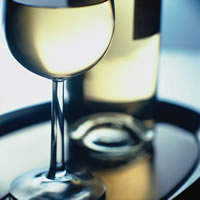The Wine Library's Poster Child
Northern Jersey is home to several diamonds in the rough. An area that I used to consider New York's proverbial armpit, has grown on me like a fungus. I've noticed that the sweaty skies of Newark happen to be surrounded by plenty of beautiful suburbs that white collar New York professionals call their home. During the past year that heavenly swamp that houses my beloved New York Giants called East Rutherford, has begun to seem more like an oasis from Manhattan's concrete penitentiary. Past highway 78's traffic over Jersey's scattered industrial zones and busy on-ramps leading to the now famously congested turnpike, (which we've all seen during the introduction to the Sopranos) you'll find a haven for enophiles stocked to the brim w/ 750 ml bottles of liquid salvation. Springfield, New Jersey's Wine Library is as comprehensive a store as any, and has recently made news for it's daily series of televised tastings referred to as WLTV (Wine Library T.V.) which can be viewed on their web site's homepage (links to the show are also sent via mailing list).
The man on stage, the Library's director of operations Gary Vaynerchuck, is responsible for running the show. Never to be criticized for lacking personality, Gary brings a non-traditional approach to modern wine review. Wines are selected daily by Gary, the Wine Library staff and viewers of the show using themes such as: school night wines, highly rated picks from the Wine Advocate and tastings of unfinished wines from the barrel. Special guests, like Robert Mondavi Jr., Margo Van Staavern of Chateau St. Jean and Santiago Achaval of Achaval Ferrer, have come on the show in past episodes to discuss their wines w/ Gary during tastings. Wines are tasted non-blind and Gary will regularly recommend (or pan) wines w/ scores using Robert Parker's consumer friendly 100 point scale.
Gary, like wine, is a bit of an acquired taste. His antics can be a tad over the top at first, but seem to grow infectiously fun as you become accustomed to them. His whimsical rants about the New York Jets, clips of 80's pop culture and his supporting cast of action figures seems to bring a much needed sense of levity to wine business. As Gary spits (and occasionally sips) he is never afraid to comment on a wine's bouquet w/ descriptors like 'loaded w/ dirt, sweaty socks and rocks' or tasting like 'skittles, burnt paper and horse manure,' Gary's unpret
 entious and passionate reactions to wine appear to be as honest and unique as they come. Even the nerdiest of wine geeks can be satiated by Vaynerchuck's occasional references to soil and terroir (which are almost always accurate), as he displays not only experience but depth of knowledge. It appears the show's frank commentary on over and under performing labels has hurt sales at the Wine Library nearly as much it has boosted them. WLTV has convinced me that it's more about honesty and entertainment than sales, and I'm sure that was always Gary's intention.
entious and passionate reactions to wine appear to be as honest and unique as they come. Even the nerdiest of wine geeks can be satiated by Vaynerchuck's occasional references to soil and terroir (which are almost always accurate), as he displays not only experience but depth of knowledge. It appears the show's frank commentary on over and under performing labels has hurt sales at the Wine Library nearly as much it has boosted them. WLTV has convinced me that it's more about honesty and entertainment than sales, and I'm sure that was always Gary's intention.The community of WLTV is rapidly growing. The message boards have grown from posts in the single digits to over 200 for the comical 100th episode. Vaynerchuck constantly encourages, begs and pleads for viewers to come out of the woodwork and comment after viewing. He has had continuing success in fostering a community of wine lovers to share dialogue during each episode's conclusion. The once small cult following has quickly blossomed into a refuge from the drudgery of the mundane 9 to 5 rat race.
Considering the state of a wine world laden w/ commercial saturation, odd European labels and limited 'taste before you buy' opportunities, the role of the wine critic has become invaluable. WLTV offers an alternative to obscurely written tasting notes and an opportunity to vicariously experience an unknown wines taste through a primal, honest and humorous platform. Although Vaynerchuck's palate is no more infallible than Robert Parker's or James Suckling's, any viewer can taste alongside Gary and decide for themselves whether they agree or disagree (much like Gary does by comparing his impressions to that of the Wine Advocate and Wine Spectator). If you find him totally off-base, you can always let him have it by posting on the WLTV message board.
I've found WLTV to not only be informative, but an energetically funny source of light-hearted stabs that help demystify the intimidating seas of wine snobbery. I'm happy to call myself a long time viewer and first time poster.



















